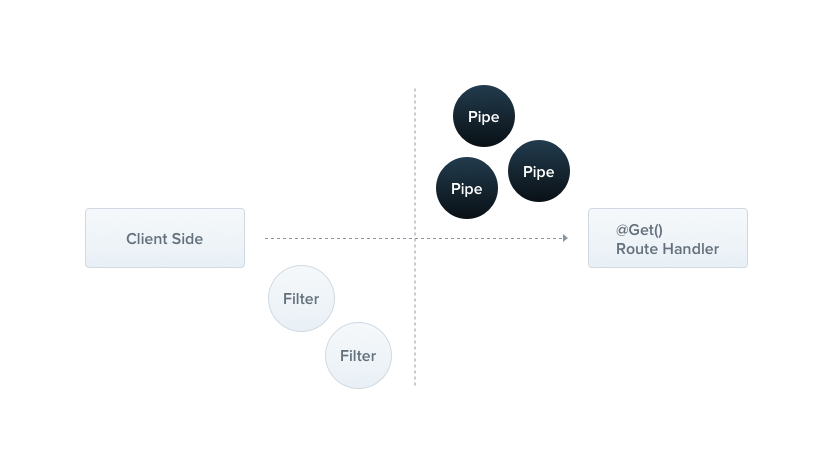
管道(Pipes)是一个用 @Injectable() 装饰过的类,它必须实现 PipeTransform 接口。
从官方的示意图中我们可以看出来管道 pipe 和过滤器 filter 之间的关系:管道偏向于服务端控制器逻辑,过滤器则更适合用客户端逻辑。
过滤器在客户端发送请求**==后==处理,管道则在控制器接收请求==前==**处理。
管道通常有两种作用:
-
转换/变形:转换输入数据为目标格式
-
验证:对输入数据时行验证,如果合法让数据通过管道,否则抛出异常。
管道会处理控制器路由的参数,Nest 会在方法调用前插入管道,管道接收发往该方法的参数,此时就会触发上面两种情况。然后路由处理器会接收转换过的参数数据并处理后续逻辑。
++小提示++:管道会在异常范围内执行,这表示异常处理层可以处理管道异常。如果管道发生了异常,控制器的执行将会停止
¶内置管道
Nest 内置了两种管道:ValidationPipe 和 ParseIntPipe。
import { PipeTransform, Injectable, ArgumentMetadata } from '@nestjs/common';
@Injectable()
export class ValidationPipe implements PipeTransform {
transform(value: any, metadata: ArgumentMetadata) {
return value;
}
}
注意这里可能不太好理解,因为我们前面已经在控制器参数上使用了 @body 装饰器,并且使用 TypeScript 的类型声明它为 CreateCatDto,如下:
async create(@Body() createCatDto: CreateCatDto) {
this.catsService.create(createCatDto);
}
但是 TypeScript 类型是静态的、编译时类型,当编译成 JavaScript 后在运行时并没有任何类型校验。这时我们就需要自己去验证,或者借助第三方工具、库来验证。
Nest 官方文档在这一节中使用了 joi 这个验证库。这个验证库的使用需要传入一个 schema,实际上对应着我们的在 Nest 中写的 dto 类型,所以我们只需要给 joi 传入一个 CreateCatDto 类的实例即可。
首页在 ValidationPipe 管道中添加 joi 的验证功能。验证通过就返回,不通过直接抛出异常:
@Injectable()
export class JoiValidationPipe implements PipeTransform {
constructor(private readonly schema: Object) {}
transform(value: any, metadata: ArgumentMetadata) {
const { error } = Joi.validate(value, this.schema);
if (error) {
throw new BadRequestException(SON.stringify(error.details));
}
return value;
}
}
¶绑定管道
管道有了,我们还需要在控制器方法上绑定它。
@Post()
@UsePipes(new JoiValidationPipe(createCatSchema))
async create(@Body() createCatDto: CreateCatDto) {
this.catsService.create(createCatDto);
}
使用 @UsePipes 修饰器即可,传入管道的实例,并构造 schema。此时我们的应用就可以在运行时通过 schema 去校验参数对象的开头了。createCatSchema 的写法可以参考相关文档。
const createCatSchema = {
name: Joi.string().required(),
age: Joi.number().required(),
breed: Joi.string().required(),
}
例如上面的 schema,如果客户端发送的 POST 请求中如果缺少任意参数 Nest 都会捕获到这个异常并返回信息:
{
"statusCode": 400,
"error": "Bad Request",
"message": "[{\"message\":\"\\\"name\\\" is required\",\"path\":[\"name\"],\"type\":\"any.required\",\"context\":{\"key\":\"name\",\"label\":\"name\"}}]"
}
注意 message 就是我们在管道中传到异常类 BadRequestException 中的参数。
¶类验证器
当然上面这种方法看起来没那么优雅,因为毕竟 CreateCatDto 和 createCatSchema 太重复了。Nest 还支持类型验证器,虽然也需要借助于三方库,但是看起来会优雅很多。
首先,要使用类验证器,你需要先安装 class-validator 库。
npm i --save class-validator class-transformer
class-validator 可以让你使用给类变量加装饰器的写法给类添加额外的验证功能。这样以来我们就可以直接在原始的 CreateCatDto 类上添加验证装饰器了,这样看起来就整洁多了,而且还没有重复代码:
import { IsString, IsInt } from 'class-validator';
export class CreateCatDto {
@IsString()
readonly name: string;
@IsInt()
readonly age: number;
@IsString()
readonly breed: string;
}
不过管道验证器中的代码也需要适配一下:
import { validate } from 'class-validator';
import { plainToClass } from 'class-transformer';
@Injectable()
export class ValidationPipe implements PipeTransform<any> {
async transform(value: any, { metatype }: ArgumentMetadata) {
if (!metatype || !this.toValidate(metatype)) {
return value;
}
const object = plainToClass(metatype, value);
const errors = await validate(object);
if (errors.length > 0) {
throw new BadRequestException('Validation failed');
}
return value;
}
private toValidate(metatype: Function): boolean {
const types: Function[] = [String, Boolean, Number, Array, Object];
return !types.includes(metatype);
}
}
注意这次的 transform 是 async 异步的,因为内部需要用到异步验证方法。Nest 是支持你这么做的,因为管道可以是异步的。
然后我们可以插入这个管道,位置可以是方法级别的,也可以是参数级别的。
++参数作用域++
@Post()
async create(
@Body(new ValidationPipe()) createCatDto: CreateCatDto,
) {
this.catsService.create(createCatDto);
}
++方法作用域++
@Post()
@UsePipes(new ValidationPipe())
async create(@Body() createCatDto: CreateCatDto) {
this.catsService.create(createCatDto);
}
管道修饰器入参可以是类而不必是管道实例:
@Post()
@UsePipes(ValidationPipe)
async create(@Body() createCatDto: CreateCatDto) {
this.catsService.create(createCatDto);
}
这样以来将实例化过程留给框架去做并肝启用依赖注入。
由于 ValidationPipe 被尽可能的泛化,所以它可以直接使用在全局作用域上。
async function bootstrap() {
const app = await NestFactory.create(ApplicationModule);
app.useGlobalPipes(new ValidationPipe());
await app.listen(3000);
}
bootstrap();
¶转换用例
我们还可以用管道来进行数据转换,比如说上面的例子中 age 虽然声明的是 int 类型,但是我们知道 HTTP 请求传递的都是纯字符流,所以通常我们还要把期望传进行类型转换。
import { PipeTransform, Injectable, ArgumentMetadata, BadRequestException } from '@nestjs/common';
@Injectable()
export class ParseIntPipe implements PipeTransform<string, number> {
transform(value: string, metadata: ArgumentMetadata): number {
const val = parseInt(value, 10);
if (isNaN(val)) {
throw new BadRequestException('Validation failed');
}
return val;
}
}
上面这个管道的功能就是强制转换成 Int 类型,如果转换不成功就抛出异常。我们可以针对性的对传入控制器的某个参数插入这个管道:
@Get(':id')
async findOne(@Param('id', new ParseIntPipe()) id) {
return await this.catsService.findOne(id);
}
¶内置的验证管道
比较贴心的是 Nest 已经内置了如上面的例子类似的一些通用验证器,你可以以参数的方式去实例化 ValidationPipe。
@Post()
@UsePipes(new ValidationPipe({ transform: true }))
async create(@Body() createCatDto: CreateCatDto) {
this.catsService.create(createCatDto);
}
ValidationPipe 接收一个 ValidationPipeOptions 类型的参数,并且这个参数继承自 ValidatorOptions
export interface ValidationPipeOptions extends ValidatorOptions {
transform?: boolean;
disableErrorMessages?: boolean;
exceptionFactory?: (errors: ValidationError[]) => any;
}
ValidatorOptions 又继承了如下所有 class-validator 的参数:
| Option | Type | Description |
|---|---|---|
skipMissingProperties |
boolean |
If set to true, validator will skip validation of all properties that are missing in the validating object. |
whitelist |
boolean |
If set to true, validator will strip validated (returned) object of any properties that do not use any validation decorators. |
forbidNonWhitelisted |
boolean |
If set to true, instead of stripping non-whitelisted properties validator will throw an exception. |
forbidUnknownValues |
boolean |
If set to true, attempts to validate unknown objects fail immediately. |
disableErrorMessages |
boolean |
If set to true, validation errors will not be returned to the client. |
exceptionFactory |
Function |
Takes an array of the validation errors and returns an exception object to be thrown. |
groups |
string[] |
Groups to be used during validation of the object. |
dismissDefaultMessages |
boolean |
If set to true, the validation will not use default messages. Error message always will be undefined if its not explicitly set. |
validationError.target |
boolean |
Indicates if target should be exposed in ValidationError |
validationError.value |
boolean |
Indicates if validated value should be exposed in ValidationError. |